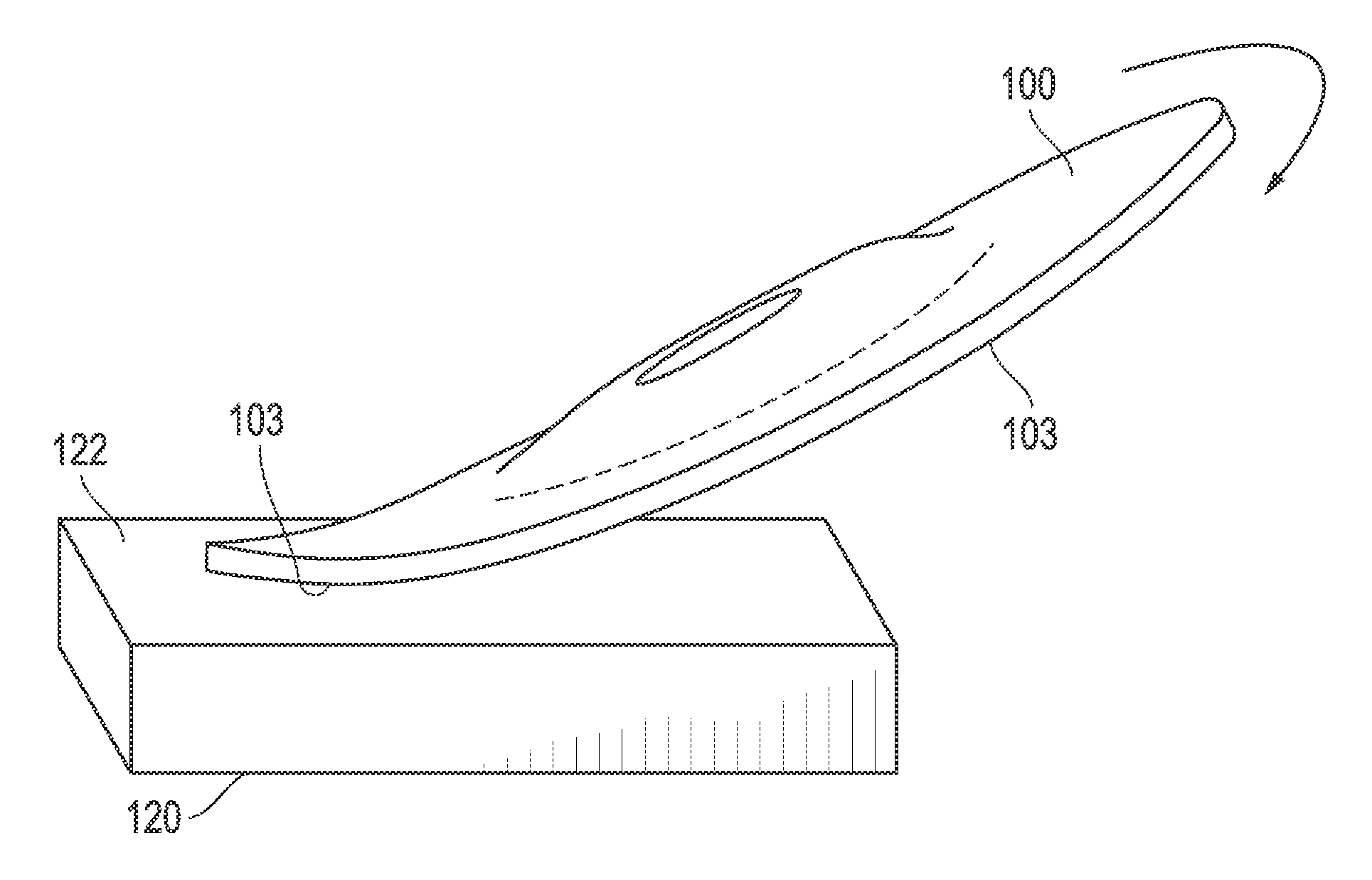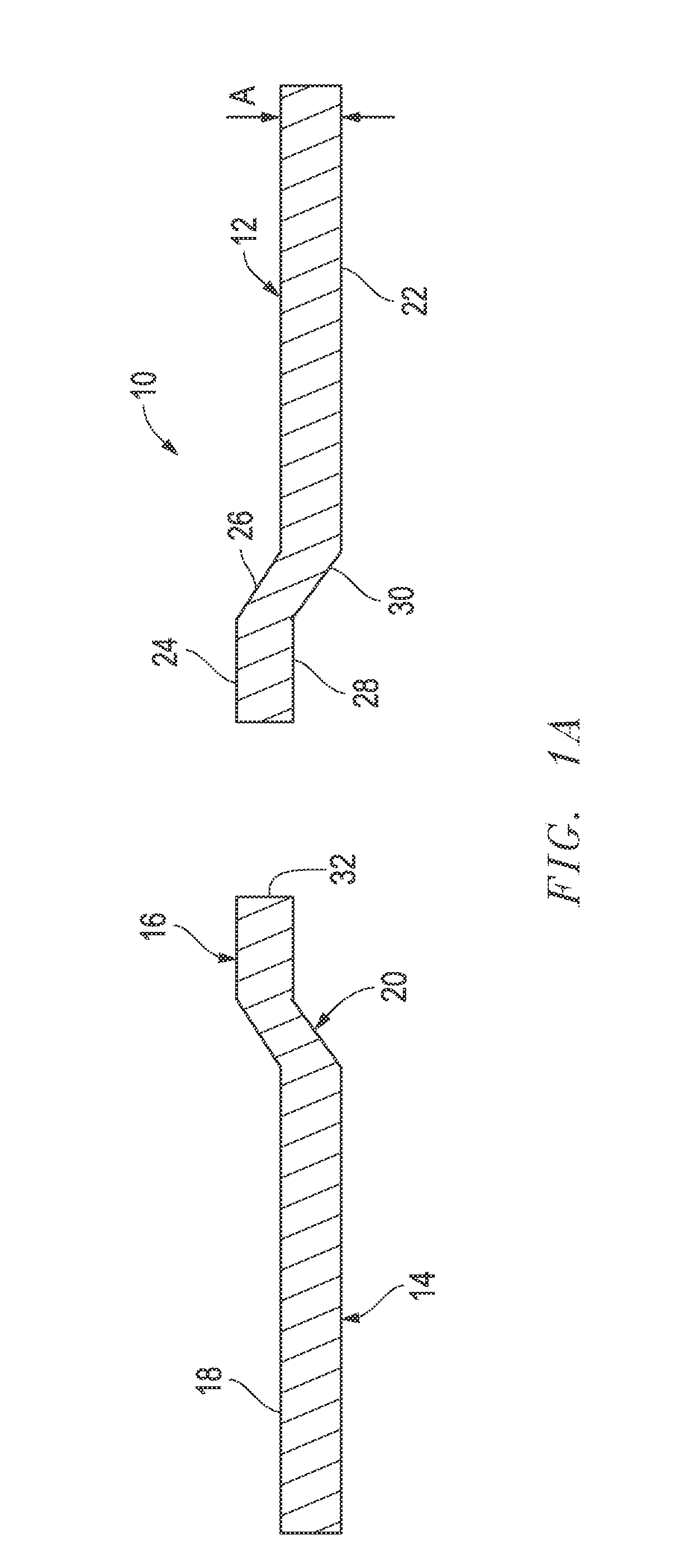Abrasive article and method of making same
a technology of abrasive articles and grinding methods, applied in the field of abrasive articles, can solve the problems of reducing the grind rate of a work piece, fatigue and failure of abrasive articles, and increasing the wear rate of abrasive articles,
- Summary
- Abstract
- Description
- Claims
- Application Information
AI Technical Summary
Benefits of technology
Problems solved by technology
Method used
Image
Examples
example 1
[0156]A first exemplary abrasive article formed according to an embodiment described herein (Sample 1) is a Type 27 wheel with the following overall dimensions:
[0157]Outer diameter / Axial thickness / Inner diameter: 125 mm / 7 mm / 22.23 mm.
[0158]Wheel Weight: 202 g+ / −10 g (e.g., about 98 g in grinding layer, and about 90 g in fineback layer).
[0159]Sample 1 includes the following layers: a blotter (of 124 mm×23 mm), a fiberglass reinforcement (of 123.5 mm by 23 mm), 85 g of a fine back abrasive layer, a second fiberglass reinforcement (of 117 mm by 23 mm), 87 g of a grinding abrasive layer, a third fiberglass reinforcement (of 123.5 mm by 23 mm), and a metal ring measuring 35 mm×6.4 mm×22.35 mm.
[0160]The grinding and fine back layers include the components provided in Table 1, including the weight percent of each component based on the total weight of the mixture used to form the layers.
TABLE 1Materialvol %Sample 1 Grinding LayerSGA coated, crushed sol-gel, 20 grit42.2%Durez 3412712.8%Dure...
example 2
[0161]Two additional exemplary abrasive articles formed according to embodiments described herein (Sample 2 and Sample 3) are also Type 27 wheels with the same layers and overall dimensions as those described in reference to Example 1. The formulations for Sample 2 and Sample 3 only differ in the type of novolac powder resin used (i.e. Sample 2 uses Durez 29346 and Sample 3 uses Durez 29722). Sample 2 and Sample 3 also include the same fine back formulation described in reference to Example 1.
TABLE 2Materialvol %Sample 2 Grinding LayerSGA coated, crushed sol-gel, 20 grit48.0%Durez 341278.4%Durez 2934614.2%Lime (CaO)0.1%Potassium7.3%AluminumFluoridePorosity22.0%Total100.0%Sample 3 Grinding LayerSGA coated, crushed sol-gel, 20 grit48.0%Durez 341278.4%Durez 2972214.2%Lime (CaO)0.1%Potassium7.3%AluminumFluoridePorosity22.0%Total100.0%
[0162]FIG. 3 depicts the grinding performance of Sample 1 and Sample 2 as compared to a comparative thin wheel abrasive article (Comparative Sample 1). Com...
example 3
[0178]The performance of an additional exemplary abrasive article formed according to embodiments described herein (Sample 4) was compared to the performance of two additional comparative samples (Comparative Sample 2 and Comparative Sample 3). Sample 4 includes ceramic abrasive particles according to embodiments described herein (i.e., SGA coated sol gel, 20 grit) while Comparative Sample 2 includes zirconia blend abrasive particles and Comparative Sample 3 includes aluminum-oxide abrasive particles.
[0179]FIG. 5 depicts a MMR for Sample 4 of at least about 48 g / min, which outperforms the MMR for Comparative Sample 2 and Comparative Sample 3.
PUM
 Login to View More
Login to View More Abstract
Description
Claims
Application Information
 Login to View More
Login to View More - R&D
- Intellectual Property
- Life Sciences
- Materials
- Tech Scout
- Unparalleled Data Quality
- Higher Quality Content
- 60% Fewer Hallucinations
Browse by: Latest US Patents, China's latest patents, Technical Efficacy Thesaurus, Application Domain, Technology Topic, Popular Technical Reports.
© 2025 PatSnap. All rights reserved.Legal|Privacy policy|Modern Slavery Act Transparency Statement|Sitemap|About US| Contact US: help@patsnap.com



